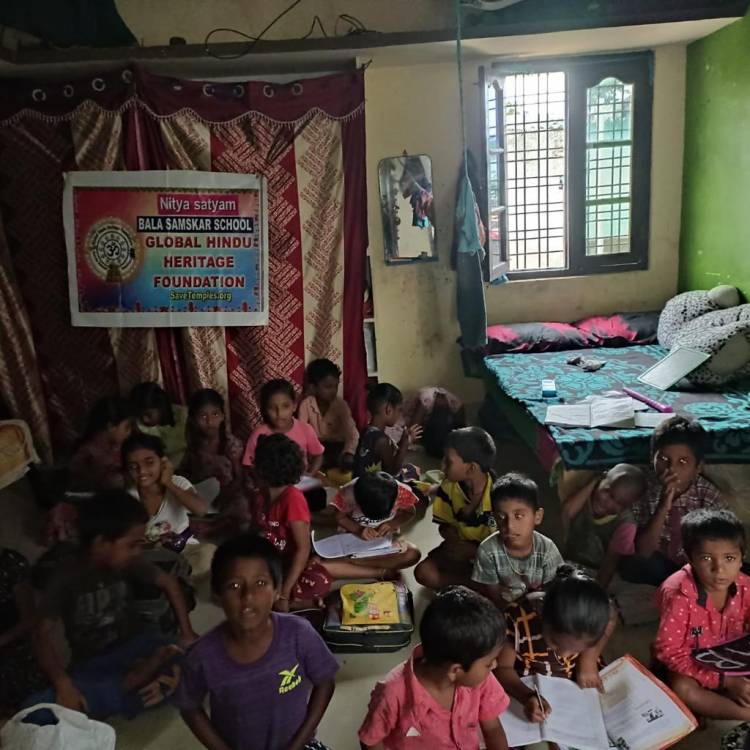[GHHF] Bala Samskar Kendras – learned about the freedom fighter Chandra Shekhar Azad who sacrificed his life for Bharat to be free from British Rule.
 Kunti’s advice to her five sons:
Kunti’s advice to her five sons:
“Warlike bulls like you don’t become cowards while faced with indomitable foes. This is your time. If you allow it to slip away without doing anything, then, although you are respected by the whole world, you will only be inflicting harm upon it.”
Global Hindu Heritage Foundation is extremely happy to update our activities pertaining to Bala Samskar Kendras. As you are aware that all Hindus should reflect on their own commitment to protect Hinduism, protect our children from being exploited by Christians, to stop the conversion through deception and allurement, and bring the converted Christians back to Hinduism,
Bala Samskar is such an attempt to protect our children being exploited by Christians. It is time to act and see what we as Hindus are doing to stop the erosion of our Hind population and also to see how our children can be protected from being lured to the Churches.
Chandra Sekhar Azad
In December 1921, when Mohandas K. Gandhi launched the Non-Cooperation Movement, Chandra Shekhar, then a 15-year-old student, joined. As a result, he was arrested and sentenced to fifteen days' imprisonment with hard punishments. From that day onward, having announced his name to be Azad (The Liberated) in court, Chandra Shekhar Tiwari assumed the name of Azad.
Revolutionary life
After suspension of the non-cooperation movement in 1922 by Gandhi, Azad became more aggressive. He committed himself to achieve complete independence by any means. Azad also believed that India's future lay in socialism. He met a young revolutionary, Pranvesh Chatterji, who introduced him to Ram Prasad Bismil who had formed the Hindustan Republican Association (HRA), a revolutionary organisation. Azad was impressed with the aim of HRA, i.e., an independent India with equal rights and opportunity to everyone without discrimination of caste, creed, religion or social status. On introduction, Bismil was impressed by Azad, when Azad reportedly put his hand over a lamp and did not remove it till his skin burnt. He then became an active member of the HRA and started to collect funds for HRA. Most of the fund collection was through robberies of government property. He also wanted to build a new India based on socialist principles. Azad and his compatriots also planned and executed several acts of violence against the British. Most of his revolutionary activities were planned and executed from Shahjahanpur which was also the hometown of Ram Prasad. He was involved in the Kakori Train Robbery of 1925, in the attempt to blow up the Viceroy's train in 1926, and at last the shooting of J.P. Saunders at Lahore in 1928 to avenge the killing of Lala Lajpat Rai. Despite being a member of Congress, Motilal Nehru regularly gave money in support of Azad.
On 27 February 1931, the CID head of the police at Allahabad, J. R. H. Nott-Bower was tipped off by someone that Azad was at Alfred Park and was having a talk with his companion and aide Sukhdev Raj. On receiving it, Bower called on the Allahabad Police to accompany him to the park to arrest him. Azad's old comrades Veer Bhadra Tiwari and Yashpal were also held responsible for tipping off two of the police constables. The police arrived at the park and surrounded it from all four sides. Some constables along with DSP Thakur Vishweshwar Singh entered the park armed with rifles and the shootout began. Azad killed three policemen but was badly wounded in the process of defending himself and helping his colleague Raj. Azad told him to move out in order to continue the freedom struggle and gave him cover fire for Raj to safely escape from the park. Azad hid behind a tree to save himself and began to fire from behind it. The police fired back. After a long shootout, holding true to his pledge to always remain Azad (Free) and never be captured alive, he shot himself in the head with his gun's last bullet. In the shootout, Bower and DSP Singh were injured in the right hand and jaws respectively. The police recovered Azad's body after the other officers arrived at the site. They were hesitant to come close to Azad even after finding him dead.
The body was sent to Rasul Abad Ghat for cremation without informing the general public. As it came to light, people surrounded the park where the incident had taken place. They chanted slogans against the British government and praised Azad.
DONATIONS
PayPal Method: To donate visit our website: savetemples.org. Click on the Donate button, then press the Purpose category, and select the General Donation category.
By Check: Or you can send a check payable to: GHHF, . It is tax-deductible.
By Zelle: ghhfusaorg@gmail.com
By Rupees, please contact us by either phone or email.
For more information, call Prakasarao V Velagapudi ; Email: ghhfusaorg@gmail.com





















 Urgent support needed for Bangladesh Hindus
Urgent support needed for Bangladesh Hindus 







